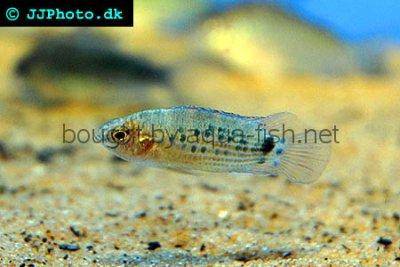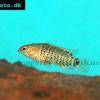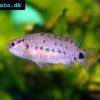Burmese badis - Badis ruber
Scientific name: Badis ruber
Common name: Burmese badis
Family: Badidae
Usual size in fish tanks: 5 - 6 cm (1.97 - 2.36 inch)
014
Recommended pH range: 6.5 - 7.3
Recommended water hardness: 4 - 17°N (71.43 - 303.57ppm)
0°C 32°F30°C 86°F
Recommended temperature range: 23 - 26 °C (73.4 - 78.8°F)
The way how these fish reproduce: Spawning
Where the species comes from: South Asia
Temperament to its own species: peaceful
Temperament toward other fish species: peaceful
Usual place in the tank: Top levels
Origin
The Burmese Badis (Badis ruber) is native to Asia, specifically found in the freshwater rivers and streams of India and Burma (Myanmar). These habitats are characterized by slow-moving waters with plenty of submerged vegetation, rocks, and leaf litter, creating an environment rich in hiding places and food sources. The natural habitat's calm, shaded waters provide a clue to the ideal conditions for keeping these fish in home aquariums.
Tank Setup and General Care
Burmese Badis thrive in a well-planted aquarium with plenty of hiding spots such as driftwood, rocks, and dense vegetation. A minimum tank size of 40 liters (10 gallons) is recommended for a small group. They prefer subdued lighting and a soft, sandy substrate to replicate their natural environment. These fish are sensitive to water conditions, so it's important to maintain stable water parameters with a pH range of 6.5-7.3 and water hardness (dGH) between 4-17°N.
To ensure the well-being of Burmese Badis, maintain a water temperature between 23-26°C (73.4-78.8°F) and keep the water flow gentle. Use a reliable filtration system that does not create strong currents, as these fish are accustomed to slow-moving waters. Regular water changes are essential to prevent the build-up of harmful substances and to keep the water quality high. While they are generally peaceful, it's advisable to keep them with similarly sized, non-aggressive tank mates.
Food and Feeding
Burmese Badis are carnivorous and prefer live or frozen foods over prepared flakes or pellets. In the wild, they feed on small invertebrates, so in the aquarium, they should be offered a varied diet consisting of bloodworms, brine shrimp, daphnia, and white worms. These protein-rich foods will enhance their coloration and support their overall health.
Feed them once or twice a day, offering only what they can consume within a few minutes to avoid overfeeding and maintain water quality. Occasionally, supplement their diet with high-quality frozen foods to provide a varied and balanced nutrition that mimics their natural diet. Their feeding behavior can also serve as an indicator of their health, so monitor their appetite and adjust the diet if necessary.
Sexing
Sexing Burmese Badis can be relatively straightforward. Males exhibit more vibrant coloration and are generally more territorial than females. During the breeding season, males' colors become even more intense, displaying bright red hues, while females remain less colorful with a more subdued appearance. The males may also develop slightly elongated fins, which further helps in distinguishing between the sexes.
Breeding
Breeding Burmese Badis in the home aquarium can be a rewarding experience. They are cave spawners, so provide plenty of small caves, plant pots, or other suitable spawning sites. Unlike some other species, Burmese Badis do not form permanent pairs but instead spawn in groups. During the breeding process, the female lays her eggs in the cave, and the male takes on the role of guarding the nest.
After spawning, the male may become protective and drive the female away from the nesting area. The eggs typically hatch within a few days, and the fry become free-swimming shortly thereafter. At this stage, they can be fed newly hatched brine shrimp or infusoria. To maximize fry survival, it's essential to maintain pristine water conditions and provide ample hiding places for the fry to avoid predation.
Lifespan
With proper care, Burmese Badis can live for 5-8 years in captivity. To ensure they reach their full lifespan, maintain a stable and clean environment, provide a varied diet, and avoid keeping them with overly aggressive tank mates that might stress them out.
Short Description
The Burmese Badis (Badis ruber) is a peaceful and intriguing fish that adds vibrant color to a planted aquarium. Known for their reclusive nature, they often spend much of their time hiding among plants and decorations, only emerging occasionally. This behavior, combined with their striking coloration, makes them a unique addition to a community tank. Due to their shy nature, they do best in a tank with plenty of hiding places and should be kept with non-aggressive, similarly sized fish. Despite their calm demeanor, they display fascinating breeding behavior, making them a favorite among aquarists looking to observe natural spawning habits in their aquarium.
Pictures
Bought by aqua-fish.net from jjphoto.dk.



 Badis
Badis  Badis
Badis  Scarlet
Scarlet